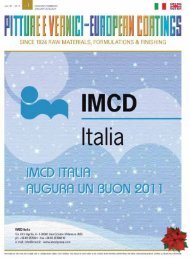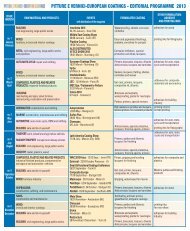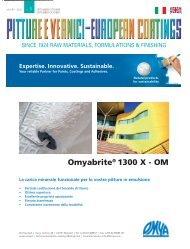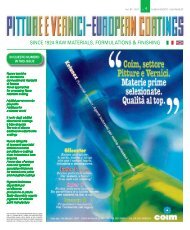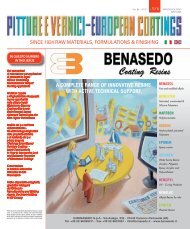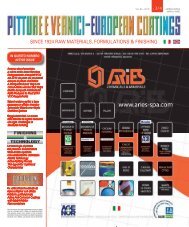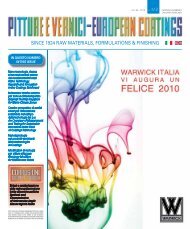qui - PITTURE E VERNICI
qui - PITTURE E VERNICI
qui - PITTURE E VERNICI
- No tags were found...
Create successful ePaper yourself
Turn your PDF publications into a flip-book with our unique Google optimized e-Paper software.
PRODOTTI FINITINo solventi, minoreattrito=minore consumodi combustibileNo solvents, Lessfriction = Less fuelLong term: Renewableraw materialsmodificazione CNTCNT - modificationEconomia eambienteEconomy andEnvironmentStabilità meccanicae erosivaErosion &mechanical StabilityStabilitàagli UVUV stabilityFig. 2 Sfide e soluzioni con le pitture per servizio pesante destinate all’usoin marina / Challenges and solution approaches regarding heavy-dutymarine paintste da SINTEF in Norvegia. Questi risultati,che comprendono una resistenzaall’usura superiore, migliori proprietàantivegetative, minore porosità superficialee rugosità ed ancora minore consumodi combustibile, corrispondentea massima velocità sono tutti direttamenteo indirettamente correlati allapresenza del CNT. La superiore resistenzaall’usura è un effetto diretto diCNT, per contro, la minore porosità èun effetto indiretto dovuto alla possibilitàdi formulare pitture a base di CNTesenti da solvente - i pori infatti sonocausati dall’evaporazione del solventeresiduo.L’assenza di pori rende difficile ai cirripedie a specie marine simili l’insediamentosulla superficie, <strong>qui</strong>ndil’effetto antivegetativo è più efficace.L’assenza di pori e l’area superficialemeno estesa rende inoltre possibileutilizzare agenti a rilascio lento, secondomodalità tecnologicamente piùTempi inutilizzodella naveVesseldowntimeAntivegetative& antighiaccioAnti-fouling& anti-icingModificazione epossidica, stabilitàagli UV, antiossidanti stabilizzantiModified epoxy, UV stabil.,antioxidants, stabilizersPotlifee..vita utileprolungate del pvPotlife.. Longer lifetimeof coatingadditivi: CNT alternatial TBTAntighiaccio?TBT alternativesCNT-additive, anti-icing?Fig. 3 Due esempi di imbarcazioni rivestite con “Green Ocean Coatings”.Quattro motoscafi, navi vedette della guardia costiera, traghetti dilinea e navi LNG con una riduzione del fabbisogno di carburante parial 10%, alternato a un possibile incremento della velocità massima del10%. Tutto questo è dovuto alla bassa rugosità superficiale e all’assenzadi pori che normalmente creano attrito e insediamento di microrganismi/ Two examples of vessels coated with ”Green Ocean Coatings”.For speed boats, coast guard patrol boats, passenger ferries and LNGvessels typically 10% reduced fuel demand has been measured, alternativelya 10% top speed increase is possible. The likely prime reasonis the low surface roughness and the absence of pores which normallycreate drag and lead to biofoulingavanzate. Re-Turn AS ha eseguito provedimostrative delle pitture su varietipologie di imbarcazioni, in cooperazionecon industrie quali Hydrolift, Hurtig-Rutene BW Gas. Nel 2010, BWGas, la flotta navale norvegese cheopera con più di 200 navi, ha investitonella transizione di Re-Turn - AdvancedMarine Coatings AS. In questo modo,è stato promosso l’ulterioresviluppo commerciale dei “Green OceanCoatings” (fig. 3).L’industria ha continuato ad impegnarsinelle attività di R&D e di integrazionedel CNT funzionale nelle pitture enei compositi. La grande sfida lanciataagli utilizzatori di CNT può esserespiegata così: se è vero che CNT inquanto tale è più forte dell’acciaio, l’incrementoconsistente di tenacità, delmodulo, della resistenza a rottura e altreproprietà nei sistemi compositispesso è classificabile soltanto nell’ordinedi grandezza del 30%, (1), secondoZhou et al.È bene accennare inoltre che l’aggiuntadi CNT nella percentuale di soltantolo 0,5% offre queste migliorie che,tuttavia, concentrazioni di CNT superiorinon forniscono esiti migliorativi.Se il CNT non è disperso in modo adeguatoe/o contiene tensioattivi residui,la prestazione del composito non ne risentepositivamente. La perfetta dispersionedi CNT può aumentare latemperatura di transizione vetrosa (Tg)della resina, ad esempio l’epossidica,fino a 20°C e una dispersione insufficientepuò ridurla. Di conseguenza, lagrande sfida consiste proprio nell’ottenerecon facilità la dispersione adeguatae, ancora di più, nel legare CNTalla matrice polimerica (fig. 4). Per ottenereuna maggiore resistenza allapropagazione delle microscrepolaturee per aumentare la tenacità, CNT deveformare un legame a ponte molto resistenteall’interno della resina, coprendouna distanza pari ad almeno 500nanometri. Ovviamente, i legami covalentifra CNT e l’epossidica o l’amminarinforzano il composito nel modo ottimale,come dimostrato da a.o. PasiKeinänen, Amroy Oy, Università di Jyväskyla, Finlandia. Di conseguenza, lastabilizzazione dei compositi a livellonano-micrometrico e la maggiore resistenzaa fatica correlata costituisconoun vantaggio che può essere ascrittounicamente alla presenza di CNT.Il compito principale, allo stato attuale,è quello di incrementare il grado difunzionalità del CNT e di ibridare i sistemiCNT con altre molecole, salda-FINISHED PRODUCTS28Pitture e Vernici - European Coatings • 10 / 2010sible to use slow-release agents in a moresophisticated manner.Re-Turn AS could demonstrate the paintson various vessels and vessel types, in cooperationwith companies such as Hydrolift,Hurtig-Ruten and BW Gas. In 2010, BWGas, the Norwegian fleet owner operatingmore than 200 large vessels, invested intoRe-Turn’s spin-off company Advanced MarineCoatings AS. This should boost the furthercommercial development of “GreenOcean Coatings”. (Fig.3)The Company continues with further R&Dand integration of functional CNT intopaints and composites. The general challengefor CNT users is: whilst CNT as suchare stronger than steel, the real improvementof strength, modulus, fracture toughnessetc. in composite systems is often“only” in the order of 30%, (1) by Zhou etal. It should be mentioned that only as littleas 0,5% added CNT achieve this improvement,however, larger CNT concentrationsdo typically not provide further improvements.If CNT are not properly dispersedand/or contain residual surfactants,the composite performance will not be improved.Perfect CNT dispersion may increasethe glass transition temperature (Tg)of a resin such as epoxy by up to 20 o C,however, insufficient dispersion may decreasethe Tg! Therefore, a key challengeis to provide easy dispersion and even betterbonding between CNT and the polymermatrices. (Fig. 4) In order to obtain betterresistance against micro-crack propagationand increased strength, CNT’s need to providea strong bridge within the resin at leastcovering a distance of 500 nanometers. Obviously,covalent bonds between CNT andepoxy or amine reinforce the composite inthe best way as documented by a.o. PasiKeinänen, Amroy Oy and University ofJyväskylä, Finland. Thus, stabilization ofcomposites at the nano- or micro-level andthus increased fatigue resistance is a benefitwhich can be ascribed solely to the p-resence of CNT. Our principal task is nowto move from today’s functionalized CNT toa higher degree of functionalization, and finallyto hybrid systems of CNT and othermolecules which are strongly bonded to C-NT’s. These auxiliary molecules offer functionalsites for covalent bonding andintegration into plastics and composites.(Fig.5). For this purpose, Re-Turn uses noveldispersion technology as well as supercriticalCO2.The results are used in a Eurostars projecton the development of epoxy andpolyurethane gelcoats for wind powerwings. (Fig.6) The challenges in this fieldare <strong>qui</strong>te similar to those in the marinepaints area, except that weight saving, preventionof UV radiation induced ageing andimproved fatigue behavior, erosion resistanceetc. are even more critical. A furtherchallenge is given by the fact that the necessarymultitude of gelcoat ingredients,such as A- and B-component of epoxy orpolyurethane, viscosity modifiers, CNT, defoamers,pigments and other additivesstrongly interacts. Mixing conditions, mixingsequences and handling are thereforevery critical for success. Re-Turn has now,after one year of the project, “zero versions”of gelcoats available which are very hydrophobic,abrasion resistant and easy toapply. These “zero versions”, both as epoxyand based on other li<strong>qui</strong>d resins, are currentlytested in the shape of kayaks (Fig. 7).The production of kayaks has some resemblanceto the manufacture of windpower wings. In addition, after a tough testingperiod using professional paddlers, thekayaks can be subjected to destructive testingseries which will allow us to improvethe formulations further.By the end of 2010, Re-Turn intends to produceand install real rotor blades on windpower installations and to start the necessaryapproval processes.▼▼



